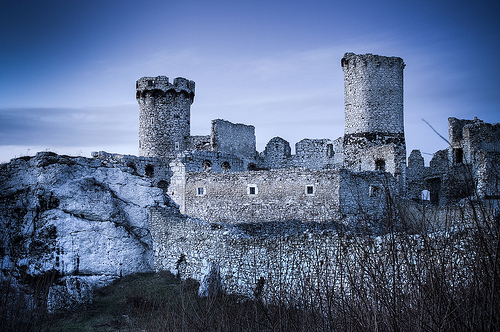Castle of the Week Hluboká nad Vltavou Castle, Bohemia, Czech Republic

The town of Hluboká nad Vltavou in southern Bohemia, the Czech Republic is home to a spectacularly romantic Neo-Gothic Castle. One of the most visited castles in the Czech Republic, Hluboká, rises on the northern edge of Budějovické pond basin, on the sharp promontory above the Vltava river. Originally a royal castle, Hluboka (Frauenberg) was founded together with the neighboring town of České Budějovice in the 13th century by the Czech King Premysl Otakar II. The King constructed the early Gothic castle around 1250, this was rebuilt at the end of the 16th century by the Lords of Hradec. Several aristocratic families took turns owning it. The important ones included the Lords of Pernštejn, who founded the nearby fishpond of Bezdrev in 1490, the second largest fishpond in Bohemia. The prominent aristocratic family of the Lords of Hradec purchased the domain in 1561. Two years later, the new owners had the original Gothic castle rebuilt into a Renaissance chateau.
In the late 16th century, the castle came into the possession of the Malovec family of Malovice, who, being Protestants, lost the property in 1619, and four years later Emperor Ferdinand II of Habsburg gave it as a compensation for war claims to the Spanish general Don Balthasar de Marradas. In 1661, Jan Adolf I of Schwarzenberg bought Hluboká from his nephew. The Schwarzenbergs lived in Hluboká until the end of 1939, when the last owner Dr. Adolf emigrated overseas to escape from the Nazis. They lost their property once for all through a special Act, Lex Schwarzenberg in 1947. Thanks to their very well-managed property and large-scale economic activities, the Schwarzenbergs twice rebuilt the chateau of Hluboká, first in the early 18th century in the Baroque style, and later, they carried out an extensive reconstruction of the chateau in the romantic neo-Gothic style of the in the years 1840 – 1871, including a re-arrangement of the park and the surrounding countryside. The rebuilding was influenced by the journeys of the then owner, Prince Jan Adolf II of Schwarzenberg and his spouse Princess Eleonore, née Princess of Liechtenstein, to England. The main model of the project was the royal castle of Windsor. Rebuilding work were started according to the designs by the Viennese architect Franz Beer, and, after his death, the Schwarzenberg builder Damasius Deworetzky continued, especially focusing on designing the splendid interiors. They created an object with 140 lavishly furnished rooms, with eleven towers (the main one is 60 m tall) and bastions, whose indented facade is dominated by a large Schwarzenberg heraldry with the family motto “NIL NISI RECTUM” (Nothing but the right). In the vicinity of the castle, there is the English style Castle Park. In the original riding hall with an open-frame hall, collections of Aleš South Bohemian Gallery are now installed.Today, in the former castle riding school, is situated a South Bohemia Gallery of Mikuláš Aleš, with an outstanding exhibition of Gothic paintings and statues as well as of Dutch and Flemish art from the 17th and 18th centuries and with changeable exhibitions in the main hall. In the mid 19th century a riding lodge was built next to the castle. Today it houses the Aleš South Bohemian Gallery which displays exquisite Gothic paintings and statues.





